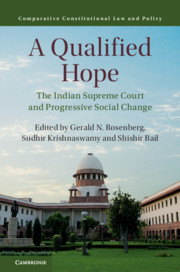Book contents
- A Qualified Hope
- Comparative Constitutional Law and Policy
- A Qualified Hope
- Copyright page
- Contents
- Notes on Contributors
- Foreword
- Acknowledgments
- Introduction
- Part I The Supreme Court of India – An Institutional Overview
- Part II The Supreme Court of India, Social and Political Mobilization
- Part III Welfare Rights and the Environment
- Part IV Discrimination
- Conclusion
- References
Part I - The Supreme Court of India – An Institutional Overview
Published online by Cambridge University Press: 19 August 2019
- A Qualified Hope
- Comparative Constitutional Law and Policy
- A Qualified Hope
- Copyright page
- Contents
- Notes on Contributors
- Foreword
- Acknowledgments
- Introduction
- Part I The Supreme Court of India – An Institutional Overview
- Part II The Supreme Court of India, Social and Political Mobilization
- Part III Welfare Rights and the Environment
- Part IV Discrimination
- Conclusion
- References
Summary
The Indian Supreme Court sits in panels and can have up to 31 judges. This chapter explores how the Indian Supreme Court developed its current structure and the impact of this structure on its functioning. It argues that the Supreme Court’s structure has a range of inter-related effects that includes increasing access to the Court, producing a “polyvocal” jurisprudence that destabilizes stare decisis, spurring experimentation among judges, fostering a “Chief Justice dominant” Court, and reducing the perceived partisanship of judges. Mapping the structure of the Court, as well as the Court’s relationship with the rest of the judiciary, helps us appreciate how judges ultimately interpret the law and the Constitution not in isolation, but within a larger judicial architecture.
Keywords
- Type
- Chapter
- Information
- A Qualified HopeThe Indian Supreme Court and Progressive Social Change, pp. 21 - 148Publisher: Cambridge University PressPrint publication year: 2019



